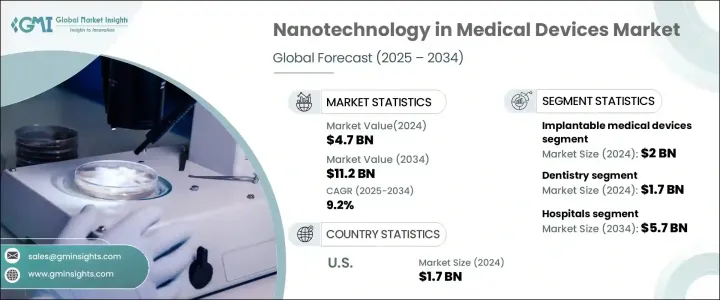
의료기기 나노기술 세계 시장은 2024년 47억 달러로 평가되었으며, 2025년부터 2034년까지 연평균 복합 성장률(CAGR) 9.2%로 성장할 것으로 예측됩니다.
이러한 놀라운 성장 궤도는 나노의료 채택 증가, 개인화된 의료 치료로의 이동, 소형 휴대용 장치에 대한 수요 증가 등 여러 요인에 의해 초래됩니다. 기술이 발전함에 따라 나노기술은 고효율 약물 전달 시스템을 가능하게 하고, 장치의 성능을 향상시키고, 전반적인 환자 관리를 강화함으로써 의료기기의 상황에 혁명을 일으키고 있습니다. 나노입자와 나노튜브의 통합과 같은 최첨단 진보는 보다 정밀할 뿐만 아니라 보다 내구성 있고 효율적인 의료기기를 만들기 위한 흥미로운 새로운 가능성을 이끌어 냅니다. 지속적인 R&D는 나노기술의 한계를 계속 넓혀 시장 성장의 추가 가속화를 약속하는 획기적인 제품에 대한 길을 열고 있습니다. 이 기술의 지속적인 탐구는 삶을 변화시키는 혁신에 대한 문을 열고 건강 관리의 미래를 변화시킵니다.

시장은 제품 유형별로 분류되며 이식형 의료기기, 치과재료, 상처 케어 제품 등이 주요 부문이 되고 있습니다. 그 중에서도 이식 가능한 장치는 가장 크고 가장 중요한 카테고리이며 2024년에는 20억 달러의 수익을 올렸습니다. 나노기술은 첨단 나노코팅 및 나노입자 개발과 같은 이러한 장비에 사용되는 재료를 발전시켜 이 부문에 큰 영향을 미칩니다. 이러한 기술 혁신을 통해 임플란트는 인체와의 적합성을 높이고 거부 반응의 가능성을 줄이고 전반적인 성능을 향상시킵니다. 긴 수명화와 임플란트와 주변 조직의 원활한 통합은 나노기술의 주요 이점입니다.
| 시장 범위 | |
|---|---|
| 시작 연도 | 2024년 |
| 예측 연도 | 2025-2034년 |
| 시작 금액 | 47억 달러 |
| 예측 금액 | 112억 달러 |
| CAGR | 9.2% |
의료기기 나노기술 시장은 최종 사용자별로도 세분화되어 있으며, 병원, 전문 클리닉 및 기타 의료시설이 선도하고 있습니다. 병원 부문은 2034년까지 57억 달러에 달할 것으로 예상되며 최대 시장 점유율을 차지합니다. 나노기술 구동 의료기기의 주요 소비자인 병원은 진단 정확도, 치료 효과 및 환자 결과를 개선하기 위해 나노 센서, 고급 이미지 시스템 및 최첨단 약물전달 플랫폼에 점점 더 주목을 받고 있습니다. 최첨단 기술에 중점을 둔 투자로 병원은 더 나은 건강 관리 제공과 환자 관리를 목표로 시장 성장의 원동력이 되고 있습니다.
미국에서 의료기기 나노기술 시장은 2024년에 17억 달러에 달했으며, 2034년까지의 CAGR은 8.4%를 나타낼 전망입니다. 이러한 성장은 민간 부문의 강력한 투자와 함께 특히 국립위생연구소(NIH)와 같은 조직의 실질적인 정부 지원에 의해 촉진되고 있습니다. 미국은 맞춤형 의료를 주도하고 있으며, 보다 치밀한 치료, 고급 진단 도구, 특정 바이오마커에 초점을 맞춘 치료 등에 나노기술을 활용하고 있습니다. 이러한 정밀의료의 추진은이 지역 시장 급성장에 기여하는 중요한 요소입니다.
The Global Nanotechnology In Medical Devices Market, valued at USD 4.7 billion in 2024, is projected to grow at a CAGR of 9.2% from 2025 to 2034. This impressive growth trajectory is driven by several factors, including the increasing adoption of nanomedicine, the shift toward personalized healthcare treatments, and the growing demand for smaller, portable devices. As technology evolves, nanotechnology is revolutionizing the medical device landscape by enabling highly efficient drug delivery systems, improving device performance, and enhancing overall patient care. Cutting-edge advancements, such as the integration of nanoparticles and nanotubes, are unlocking exciting new possibilities for creating medical devices that are not only more precise but also more durable and efficient. Ongoing research and development continue to push the boundaries of nanotechnology, paving the way for breakthrough products that promise to further accelerate market growth. The continuous exploration of this technology opens doors to life-changing innovations, transforming the future of healthcare.

The market is categorized by product types, with implantable medical devices, dental materials, wound care products, and others as the key segments. Among them, implantable devices are the largest and most significant category, generating USD 2 billion in 2024. Nanotechnology has made a profound impact on this segment by advancing the materials used in these devices, such as the development of advanced nanocoatings and nanoparticles. These innovations are making implants more compatible with the human body, reducing the likelihood of rejection, and improving their overall performance. The enhanced longevity and seamless integration of implantable devices with surrounding tissues are key benefits that nanotechnology is bringing to the table.
| Market Scope | |
|---|---|
| Start Year | 2024 |
| Forecast Year | 2025-2034 |
| Start Value | $4.7 Billion |
| Forecast Value | $11.2 Billion |
| CAGR | 9.2% |
The nanotechnology in medical devices market is also segmented by end-users, with hospitals, specialty clinics, and other healthcare facilities leading the way. The hospital segment is expected to reach USD 5.7 billion by 2034, holding the largest market share. As the primary consumers of nanotechnology-driven medical devices, hospitals are increasingly turning to nanosensors, advanced imaging systems, and cutting-edge drug delivery platforms to improve diagnostic accuracy, treatment efficacy, and patient outcomes. The heavy investments in state-of-the-art technologies make hospitals a driving force in market growth as they continue to lead the charge toward better healthcare delivery and patient care.
In the U.S., the nanotechnology in medical devices market reached USD 1.7 billion in 2024, with a projected CAGR of 8.4% through 2034. This growth is fueled by substantial government support, particularly from organizations like the National Institutes of Health (NIH), alongside strong private sector investments. The U.S. is leading the charge in personalized medicine, using nanotechnology for more targeted treatments, advanced diagnostic tools, and therapies focused on specific biomarkers. This drive for precision medicine is a key factor contributing to the rapid market growth in the region.